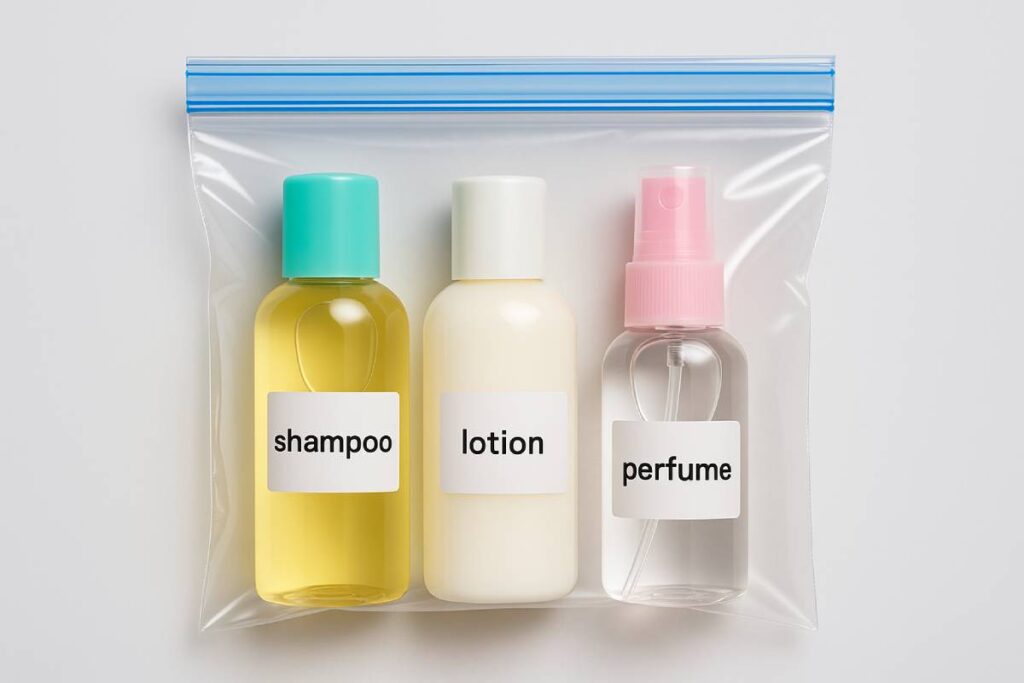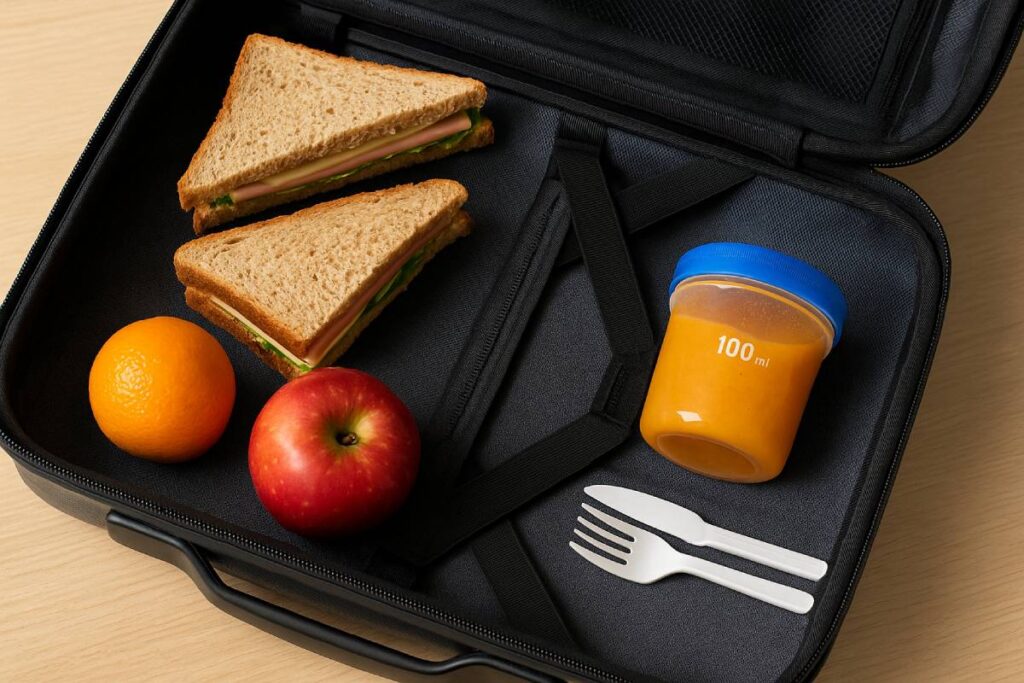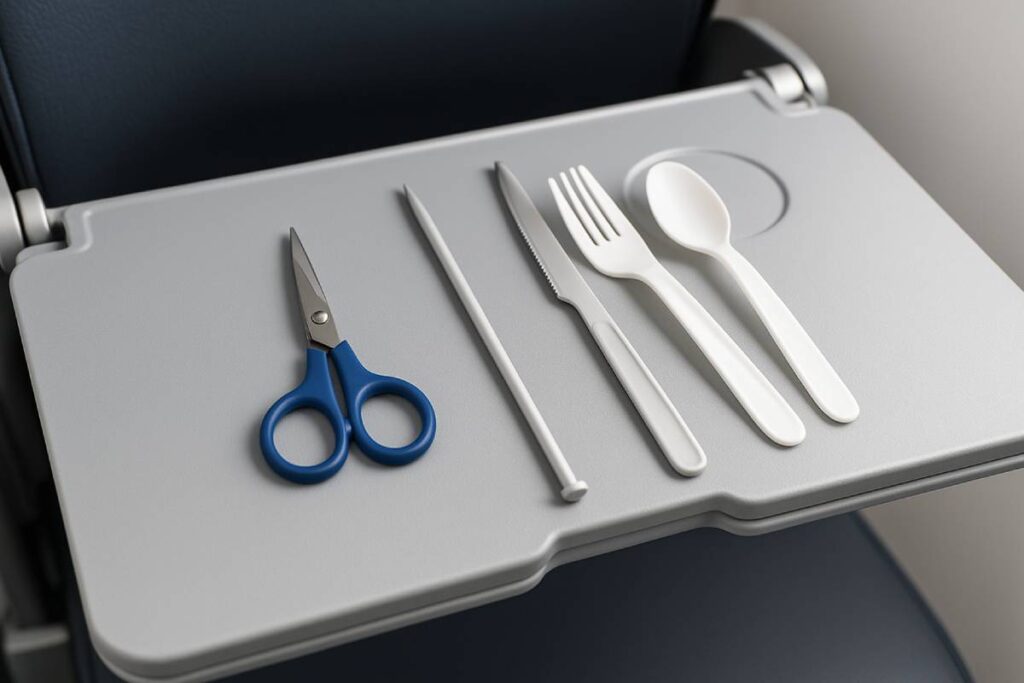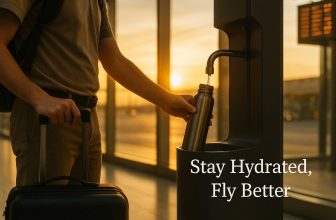Step up to the security line with confidence—no more last-minute tug-of-war over your liquids, gadgets, or snacks.
In the summer of 2024, TSA screened a record 2.99 million passengers in a single day—a sign that airport checkpoints have never been busier. Yet, millions still face delays or confiscations for simple packing mistakes.
From the 3-1-1 liquids rule to lithium-battery limits and CT-scanner upgrades, this guide decodes every rule you need to know in 2025 to keep your carry-on compliant and your journey stress-free.
Why Carry-On Rules Matter
Below is an expert breakdown of why strict carry-on security rules are essential—for safeguarding everyone aboard and avoiding costly screening delays or penalties.
In essence, standardized carry-on regulations remove potential threats before boarding, leverage advanced imaging to speed throughput, and maintain a predictable, efficient screening process. Ignoring these rules not only risks longer waits and bag pull-asides but also immediate confiscation of forbidden items and civil fines that can range from hundreds to tens of thousands of dollars.
Security Rationale
Carry-on rules exist first and foremost to keep dangerous items out of the cabin, reducing fire, chemical or weapon risks before boarding begins.
- Carry-on regulations classify items like flammable gels, aerosols, and sharp objects so that X-ray systems and officers can reliably spot and remove them at security checkpoints.
- Advanced screening technologies, such as Computed Tomography (CT) scanners, generate 3D bag images that greatly improve threat detection accuracy and slash the need for manual bag searches.
- In FY 2022, TSA deployed 243 CT X-ray scanners nationwide to boost throughput and enhance security effectiveness across busy U.S. airports.
- Standardized measures like the 3-1-1 liquids rule (3.4 oz containers in a 1-quart bag) streamline what passengers pack, enabling officers to spot anomalies faster and keep lines moving.
Consequences of Non-Compliance
Failing to follow carry-on rules carries immediate and far-reaching impacts for you—and everyone in line behind you.
- Secondary Screening Delays
Bags with prohibited items are pulled aside for additional inspection, often adding 10–20 minutes per passenger and increasing stress or risking missed connections. - Confiscation of Prohibited Items
Any forbidden object—whether a large liquid container, oversized tool, or undeclared lithium battery—is seized on the spot, with no opportunity for recovery during travel. - Civil Penalties
TSA’s civil enforcement can impose fines up to $17,062 per violation, with repeat offenses drawing even higher penalties. - Specific Violation Fines
- Flammable gels/creams over 3.4 oz: $390–$2,250
- Blasting caps or >10 oz of gunpowder: $8,960–$14,950
- Firearm in carry-on: up to $15,000 (first offense), plus loss of TSA PreCheck for five years and possible law enforcement involvement
- Real-World Stakes
In 2024 alone, TSA officers intercepted 6,678 firearms at security checkpoints—proof that rigorous carry-on screening is preventing dangerous items from reaching aircraft cabins. - Collective Impact
Beyond individual penalties, non-compliance creates bottlenecks that slow the entire line. Respecting carry-on rules is both a personal duty and a community consideration.
Civil Penalties at a Glance
| Violation Type | Penalty Range | Additional Consequence |
|---|---|---|
| Flammable gels > 3.4 oz | $390–$2,250 | Item confiscation |
| Any prohibited item | Up to $17,062 | Repeat violations carry steeper fines |
| Firearm in carry-on | Up to $15,000 | Loss of PreCheck for 5 yrs; possible arrest |
By understanding the security rationale and the serious consequences of non-compliance, you can pack smarter, speed through TSA screening, and avoid fines or flight disruptions.
2025 Regulatory Landscape
Below is an expert overview of the 2025 regulatory landscape, highlighting how U.S. carry-on rules compare with international standards and the major policy updates travelers need to know this year.
In 2025, carry-on regulations remain globally harmonized around core safety measures—100 ml liquid limits (3-1-1), battery watt-hour caps, and advanced imaging screening—yet regionally vary in container sizes, CT-scanner deployment, and carrier-specific baggage allowances. The TSA permits up to two spare lithium-ion batteries of 101–160 Wh with airline approval, while IATA guidelines mirror these caps and add recommended state-of-charge limits effective January 1, 2025. Meanwhile, EU member states are rolling out CT scanners to allow 2 L of liquids in a single sealed bag—though the UK extended full implementation until June 2025—and airlines like Air Canada have introduced new fare-based carry-on bans.
TSA vs. International Authorities
Key Similarities
- Liquid Limits (3-1-1 Rule): Both TSA and bodies like ICAO/IATA enforce containers ≤ 100 ml in a single quart-sized bag per passenger, simplifying threat detection and line throughput.
- Battery Watt-Hour Caps: Carry-on batteries must not exceed 100 Wh, with spare batteries of 101–160 Wh allowed under defined limits—up to two spares per person—with items over 160 Wh restricted to cargo transport.
- Prohibited Items: Sharp objects, self-defense gear, and flammable aerosols are universally banned in carry-on across TSA, EU/EASA, UK CAA, and other national authorities.
Key Differences
| Aspect | TSA (U.S.) | International (IATA/EU/UK) |
|---|---|---|
| Dimensional Guidelines | Defers to airlines (e.g., average 22 × 14 × 9 in) | Recommends 56 × 45 × 25 cm (22 × 18 × 10 in); Canada: 55 × 40 × 23 cm |
| Battery Carry Rules | ≤ 100 Wh unlimited; 101–160 Wh (max two spares with approval) | Same base limits; IATA caps spares at 20 under 100 Wh, two spares 101–160 Wh; > 160 Wh cargo only |
| Liquid Screening Tech | Standard X-ray at most airports; phased CT-scanner rollout | EU rolled out CT scanners Sept 1, 2024 (two-liter rule pilots); UK full CT rollout now delayed to June 2025 |
| Special-Need Exceptions | TSA Cares for medical devices; documented meds allowed | ICAO/IATA also exempt prescription meds, baby food under inspection protocols |
Recent Policy Updates
What Changed in 2025
| Update | Effective Date | Details |
|---|---|---|
| EU Two-Liter Rule via CT Scanners | Sept 1, 2024–mid 2025 | Select EU airports began using CT scanners to allow up to 2 L of liquids in a sealed bag under advanced imaging; UK extended deadline to implement new scanners until June 2025 |
| IATA State-of-Charge Recommendation | Jan 1, 2025 | Recommended that lithium-ion batteries in equipment be offered at ≤ 30% state of charge to reduce thermal-runaway risk; mandatory from Jan 1, 2026 |
| Air Canada Basic Economy Carry-On Ban | Jan 3, 2025 | Basic-fare tickets no longer include standard carry-on allowance—passengers limited to a personal item only |
| TSA & DHS Next-Gen Screening Push | Throughout 2025 | Joint TSA/DHS initiative expanding next-generation CT X-ray and AI-driven screening technology to improve detection and speed traveler throughput |
| TSA Spare Battery Clarification | Late 2024 Update | Reaffirmed policy: passengers may carry up to two spare lithium-ion batteries (101–160 Wh) in carry-on with airline approval; batteries ≥ 160 Wh remain prohibited in cabin |
These aligned yet nuanced regulations underscore the importance of checking both TSA guidance and your airline’s specific policy before flying.
Liquids, Gels & Aerosols

Below is a practical, expert-led dive into Liquids, Gels & Aerosols for 2025 travel—explaining the 3-1-1 rule, detailing vital exceptions, and sharing pro packing hacks. By mastering these guidelines, you’ll breeze through security and keep your favorite toiletries at hand.
The 3-1-1 Rule Explained
Under the TSA’s 3-1-1 rule, each traveler may carry liquids, gels and aerosols in containers no larger than 3.4 ounces (100 milliliters), all fitting into a single quart-sized (≈ 0.95 L) clear, resealable bag—one bag per passenger.
- 3 = containers ≤ 3.4 oz (100 ml)
- 1 = one quart-size, clear, zip-top bag
- 1 = one bag per traveler
At screening, you must remove this bag from your carry-on to place it in a bin for separate X-ray inspection, which speeds up conveyor throughput and reduces manual checks.
Exceptions & Exemptions
While the 3-1-1 rule is strict, critical items get a pass—just declare them at the checkpoint:
| Item Type | Allowance | Screening Notes |
|---|---|---|
| Medications | No size limit if “medically necessary”; reasonable quantity | Must be declared; subject to additional inspection |
| Baby Formula/Milk | No size limit; includes breast milk and juice for infants | Remove from bag; screened separately |
| Duty-Free Liquids | > 3.4 oz if in sealed, tamper-evident (SED) bag with receipt | SED bag must remain sealed; any alarm triggers manual check |
These exemptions ensure essential items—life-saving meds, infant nutrition, and souvenirs—aren’t left behind, while still maintaining secure screening standards.
Packing Tips & Tricks
- Invest in Pre-Measured, Leak-Proof Bottles
- Use durable, silicone 3 oz travel bottles—they’re lightweight, flexible, and certified for carry-on.
- Brands like Gemice offer TSA-approved sets with secure caps to prevent spills.
- Label Clearly & Group Strategically
- Mark each bottle with its contents (e.g., “shampoo,” “sunscreen”) using waterproof labels—saves time at security and keeps you organized.
- Pack bottles upright in the center of your quart bag to minimize pressure on seals.
- Use Free Airport Bags & Pre-Cut Zip-Tops
- Many U.S. airports giveaway quart bags at security entrances—grab one if you forgot yours.
- Pre-cut gallon-size zip-tops (slightly larger) can double as a shock-absorbing layer around your quart bag.
- Freeze Liquids as Ice Packs
- Fill an extra empty bottle halfway and freeze it; use it as an ice pack for snacks or skincare, then stow as a 3 oz container once thawed.
By mastering the 3-1-1 rule, leveraging exemptions, and packing smart with the tips above, you’ll keep your essentials accessible—and security lines moving—every time you fly. Don’t forget to bookmark this guide and download our printable carry-on checklist before your next trip!
Electronics & Batteries
Below is an expert, travel-pro breakdown of Electronics & Batteries for 2025—what you need to know to sail through TSA checkpoints and keep your devices powered safely.
In 2025, all electronics larger than a cell phone—laptops, tablets, e-readers—must be removed from carry-on bags and X-rayed separately to provide clear 3D images for CT scanners and reduce manual inspections. Spare lithium-ion batteries and power banks are strictly carry-on only, with no checked-baggage exceptions, and must be individually protected against short-circuit by keeping them in original packaging, dedicated battery cases, or insulated pouches. Standard lithium-ion cells under 100 Wh require no airline approval; units of 101–160 Wh are limited to two spares per passenger with explicit airline approval; anything over 160 Wh is prohibited from both carry-on and checked bags.
Standard Electronics
Travelers must remove personal electronics larger than a cell phone—laptops, tablets, e-readers—from carry-on bags and place them alone into security bins for X-ray screening. This separation gives TSA officers unobstructed, high-resolution views to spot concealed threats, reducing the need for time-consuming manual checks. In TSA PreCheck lanes, enrolled passengers keep these devices in their bags, cutting average screening times to under 10 minutes versus 30 minutes in standard lanes.
Spare Batteries & Power Banks
- Carry-On Only: Portable chargers, power banks, and all spare lithium-ion or lithium-metal batteries are prohibited in checked luggage and must remain with you in the cabin.
- Protection Required: Each spare battery must be individually protected to prevent short-circuits—keep them in original packaging, specialized battery cases, or insulated pouches.
- Capacity Limits: Battery TypeLimitCarry-OnAirline Approval Required?Lithium-ion ≤ 100 WhUp to 100 WhYesNoLithium-ion 101–160 Wh101–160 WhYes (2)YesLithium-ion > 160 WhOver 160 WhNoN/ALithium-metal ≤ 2 g (content)Up to 2 gYesNoLithium-metal > 2 gOver 2 gNoN/A
TSA Screening Insights
- Bin Placement: Always place each device or spare battery bin – separately – with nothing on top or underneath. This simple step produces a clearer X-ray image and drastically cuts down secondary inspections.
- Power-On Requests: If asked, power on your device. A dead battery can trigger manual inspection or denial of boarding for security reasons.
- Signal Cables & Accessories: Wrap cords and tuck accessories inside your carry-on. Excess clutter can hide prohibited items and slow screening.
- Know Before You Go: Check both TSA’s “What Can I Bring?” page and your airline’s website for any stricter rules or size restrictions on electronics and batteries—policies can vary by carrier.
Bottom Line: Pack your electronics for easy removal, stow spare batteries safely in your carry-on, and be prepared to power up on request. These simple steps will keep you compliant, reduce hold-ups at security, and ensure your devices make it to the gate—and beyond—fully charged.
Medical Equipment & Special-Need Items
Below is a travel-expert overview of Medical Equipment & Special-Need Items in your carry-on for 2025. You can bring both prescription and over-the-counter medications beyond the usual 3-1-1 limits—just declare them and label clearly. Insulin pumps and CPAP/BiPAP/APAP devices are fully permitted when you notify TSA; they may remain in their case or, if inseparable, be hand-inspected to protect function. Contact-lens solutions and breast milk are exempt from size caps—declare and screen them separately to avoid delays.
Prescription Medications vs. Over-the-Counter
Travelers may carry prescription medications in amounts exceeding 3.4 oz (100 ml) if they are clearly labeled in their original containers—simply declare them at security and place them in a separate bin for screening. U.S. Customs and Border Protection likewise reminds passengers to travel only with medications prescribed to them by a licensed physician.
Similarly, over-the-counter (OTC) medications (e.g., saline solution, cough syrup) are exempt from the 3-1-1 liquids rule when medically necessary—declare and remove them from your bag to speed screening. TSA’s “Medications (Liquid)” guidance confirms that reasonable quantities of medically necessary gels and aerosols may exceed standard limits when declared.
For travelers with diabetes, the American Diabetes Association notes that diabetes-related supplies—including insulin and test kits—are always allowed once properly screened; just separate them from other items and inform the officer.
Insulin Pumps & CPAP Machines
Insulin pumps and supplies (pens, cartridges, glucose monitors) are permitted in both carry-on and checked bags—just notify the TSA officer, and ensure all insulin is clearly identified. The CDC advises never to pack insulin in checked luggage (risking extreme temperatures) and to keep supplies with you in a cooler or insulated pack.
CPAP, BiPAP, and APAP machines—along with masks and tubing—may remain in their carrying case for X-ray screening; if the device must stay connected to an external power source, you can request a hand-inspection or pat-down instead to avoid damage. UCLA Health clarifies that pumps and continuous glucose monitors can go through metal detectors but may require removal before full-body scanners, with an alternative screening option on request.
Contact-Lens Solutions & Breast Milk
Contact-lens solutions over 3.4 oz are best placed in checked baggage, but medically necessary amounts may be carried in excess of the limit if declared; officers may test or swab samples if the solution alarms. TSA’s broader “Medical” list notes that any medically necessary liquid causing an alarm can be subject to additional inspection or refusal—but declaring it avoids surprises.
Breast milk, formula, and toddler drinks are classified as medically necessary liquids with no size restriction; they need not fit in the quart bag but must be declared and screened separately. Cooling accessories (ice packs, gel packs) are likewise allowed in any quantity to maintain freshness.
Table: Medical Items Screening at a Glance
| Item | Quantity Limits | Declaration Required | Screening Procedure |
|---|---|---|---|
| Prescription Medications | No size limit; original container | Yes | Separate bin; possible manual inspection |
| Over-the-Counter Medications | No size limit if medically necessary | Yes | Declare; separate screening bin |
| Diabetes Supplies (insulin, kits) | No size limit; separate from other items | Yes | X-ray or hand inspection |
| Insulin Pumps & CGMs | No size limit; notify TSA | Yes | May stay on during X-ray; alternative screening available |
| CPAP/BiPAP/APAP Machines | No size limit; carrying case OK | Yes | Case can go through X-ray; hand inspection on request |
| Contact-Lens Solution | Exempt if medically necessary | Yes | Declare; swab or test sample if alarm |
| Breast Milk & Formula | No size limit | Yes | Declare; screened separately; cooling packs allowed |
By labeling clearly, declaring proactively, and knowing your rights, you’ll keep essential medical items within reach and move seamlessly through security—no surprises, no stress.
Food & Beverage Restrictions

In 2025, understanding which foods you can—and can’t—bring aboard is key to a smooth security experience. Solid items like sandwiches and snacks sail through checkpoints without size limits, while soups, sauces and other gel-like foods must obey the 3-1-1 rule (≤ 100 ml per container, 1-liter bag). Internationally, the EU sticks to 100 ml limits in a 1 L bag (with CT-scanner pilots extending to 2 L in some airports), and Middle Eastern carriers grant baby-food and medical exemptions when you show proof. Smart packing—vacuum-sealed snacks, clear containers, pre-labeled portions—keeps freshness and speeds screening.
Solid Foods vs. Liquids
Solid foods—think sandwiches, fruit, granola bars—are allowed in both carry-on and checked luggage without size caps, though regulators may pull bags for a quick look if items clutter the X-ray view. By contrast, liquid or gel foods (soups, sauces, yogurts) fall under the 3-1-1 rule: containers must be ≤ 3.4 oz (100 ml), fit in one quart-sized clear bag, and only one bag per passenger.
| Food Type | Carry-On | Checked Bag | Notes |
|---|---|---|---|
| Solid (sandwiches, snacks) | Yes | Yes | No size limit; may trigger extra screening if cluttered |
| Soups, broths | ≤ 100 ml (3.4 oz) | Any | Must be in quart bag under 3-1-1 |
| Sauces, dips | ≤ 100 ml | Any | Pack in clear bag; seal tightly |
| Yogurts, puddings | ≤ 100 ml | Any | Pre-portion in travel cups |
International Variations
- European Union: Mirrors the 100 ml rule with liquids in a single 1 L bag, applicable at all EU airports plus Norway, Iceland & Switzerland. CT-scanner pilots at select hubs now allow up to 2 L sealed bags—full rollout expected mid-2025.
- Middle East (e.g., Emirates, Etihad): One clear bag per passenger; baby food, breast milk, medical liquids (e.g., special dietary drinks) are exempt when you present proof—officers may open and inspect, but sizes aren’t capped.
- UK & Gulf Carriers: Post-Brexit, UK budget airlines (TUI, easyJet, Ryanair, Jet2) ban meat/dairy into the EU and restrict personal hot drinks or alcohol, though cold foods remain OK. Always check your destination’s customs rules to avoid surprises on arrival.
Packing Hacks
- Vacuum-Sealed Snacks: Lock in flavor and save space—freeze-dried meals and nuts in vacuum pouches are treated as solids, so no 3-1-1 hassle.
- Clear, Resealable Bags & Containers: Use transparent quart bags or slim acrylic tubs for sauces under 100 ml; visibility speeds officer review and cuts down bin pulls.
- Pre-Cut Silicone Reusable Bags: Eco-friendly and leak-proof, these bags flex to fit oddly shaped items and withstand inspection without tears.
- Freeze Liquids as Ice Packs: Partially fill a travel bottle, freeze it, then top off with liquid—acts as a cooling pack and meets the container limit once thawed.
By knowing the fine print on solid vs. liquid foods, respecting international nuances, and mastering these packing workarounds, you’ll stay compliant, streamline screening, and keep your favorite snacks at hand. Don’t forget to bookmark this guide and download our printable carry-on checklist for your next trip!
Sharp Objects & Tools

Below is a friendly yet authoritative breakdown of what sharp objects and tools you can—and can’t—bring in your carry-on in 2025, plus safe stand-ins to avoid surprises at the checkpoint. By knowing these rules, you’ll pack smarter, move through security faster, and keep your tools within reach when you need them.
Allowed Items
- Small scissors (< 4 inches from pivot): You may pack scissors in your carry-on so long as the blades measure under 4 inches from the pivot point.
- Round-tip knitting needles & sewing needles: Both are permitted in carry-on baggage; just sheath or secure them so they don’t poke through your bag.
Prohibited Items
- Box cutters & razor-type blades: Any loose blades or box cutters are strictly banned from carry-on and must go in checked luggage.
- Large knives & multitools with blades: Pocket knives and multi-tools that include knife blades of any length are not allowed in the cabin—pack them in checked bags instead.
Safe Alternatives
| Purpose | Alternative Option | Notes |
|---|---|---|
| Everyday shaving | Disposable razors | Permitted in carry-on; keep in original packaging or sealed pouch |
| Cutting food/snacks | Plastic or round-bladed utensils | Plastic forks, butter knives, and sporks are allowed—no metal blades to slow you down |
| Crafting on the go | Safety cutters with enclosed blades (e.g., plastic) | Designed to cut paper/cardboard without exposed metal; check airline policy if in doubt |
- Disposable razors are carry-on friendly—just stow them in a pouch or original packaging to prevent accidental nicks.
- Plastic utensils (sporks, butter knives) handle your meals and snacks without running afoul of blade bans.
- When you need more robust cutting tools, pack any sharp-bladed tool in your checked baggage—this includes box cutters, utility knives, straight razors, and multitools with blades.
Size, Weight & Quantity Limits
Bottom Line: Stick to scissors under 4 inches, round-tip needles, and replace metal blades with plastic or disposable options in your carry-on. Anything sharper belongs in your checked bag—this simple strategy will keep you compliant, expedite your screening, and prevent confiscation or fines. Safe travels!
Below is an expert breakdown of Size, Weight & Quantity Limits for carry-on luggage in 2025—covering standard dimension checklists, where weight limits apply, and a quick-reference table for major airlines. You’ll see that U.S. carriers generally mandate size but leave weight largely unenforced, while some international airlines (e.g., Emirates) impose strict weight caps. Understanding these nuances ensures you avoid gate-check surprises and unexpected fees.
Dimension Checklists
- Standard Carry-On Size (FAA/ICAO): All U.S. airlines adhere to the Federal Aviation Administration’s guideline that cabin bags must not exceed 22″ × 14″ × 9″ (56 × 35 × 23 cm)—including handles and wheels.
- American Airlines: Specifies a maximum of 22″ × 14″ × 9″ (56 × 36 × 23 cm) for all carry-on bags, with no exceptions for soft-sided garment bags outside a 51-inch total linear measurement.
- Delta Air Lines: Limits carry-on dimensions to 22″ × 14″ × 9″ (56 × 35 × 23 cm) or a combined total of 45 linear inches (114 cm).
- Emirates: Caps cabin baggage at 55 × 38 × 22 cm (21.6 × 14.9 × 8.6 in) for Economy and Premium Economy; Business & First allow two pieces (briefcase up to 45 × 35 × 20 cm and handbag up to 55 × 38 × 22 cm).
Weight Limits (Where Enforced)
- American Airlines: Imposes no official carry-on weight limit, though you must lift your bag into the overhead bin unassisted.
- Delta Air Lines: Similarly, does not enforce a weight limit for carry-ons—though gate agents may restrict heavy bags on smaller aircraft for safety and bin capacity reasons.
- Emirates: Enforces a strict 7 kg (15 lb) limit for Economy, 10 kg (22 lb) for Premium Economy, and 7 kg (15 lb) per piece for Business & First; any excess must be checked or incur an overweight fee.
Quick-Reference Table
| Airline | Max Dimensions | Max Weight | Fee for Oversize |
|---|---|---|---|
| American | 22 × 14 × 9 in (56 × 36 × 23 cm) | No official limit | Gate-check as first checked bag: $35–$75 (free if included in fare), up to $100 on some routes |
| Delta | 22 × 14 × 9 in (56 × 35 × 23 cm) | No weight limit | Gate-checked free on full flights; otherwise incurs first checked-bag fee ($35–$100) |
| Emirates | 22 × 15 × 8 in (55 × 38 × 20 cm) | 15 lb (Economy) | Varies by route and class (typically AED 100–AED 200) |
By following these dimension and weight guidelines—and referring to the table above—you’ll reduce the risk of gate-check delays or surprise fees. Always verify your specific fare class and routing on the airline’s official site before you pack.
Airline-Specific Variations
Below is a travel-expert guide to navigating airline-specific carry-on policies—covering where to look, how to read the fine print, and direct links to the top 10 carriers’ official pages.
In 2025, each airline publishes its carry-on rules under a “Baggage” or “Travel Information” section on its website, typically labeled as “Carry-On Baggage” or “Cabin Baggage Rules.” Policies vary in allowed dimensions, weight limits, fees, and exceptions—so always consult the carrier’s own page before packing.
How to Find & Interpret Each Carrier’s Carry-On Policy
- Navigate to “Baggage” on the Airline’s Website
Most airlines place carry-on details under a main menu item like Travel Info → Baggage, or via a footer link labeled “Baggage.” - Use the On-Site Search Bar
Typing “carry-on baggage” into the site’s search field will almost always return the official policy page as the top result. - Look for Key Specs
- Dimensions: Includes wheels/handles—often listed in inches and centimeters.
- Weight: Some carriers enforce strict kg/lb caps.
- Fees: Note any oversize or overweight charges.
- Exceptions: Infant allowance, basic-economy rules, medical devices.
By bookmarking each carrier’s official policy page and reviewing its exact size, weight, and fee tables before you pack, you’ll minimize gate-check surprises and breeze through security with confidence—no guesswork required!
Tips for Smooth Security Screening
By adopting four simple yet powerful strategies—strategic packing, TSA-approved kits, expedited screening enrollment, and slip-on footwear—you can slash checkpoint delays, reduce bin shuffling, and breeze through security. Organizing your bag in layers with electronics on top and your 3-1-1 liquids pouch easily accessible minimizes manual inspections. Using clear, leak-proof TSA-approved travel kits keeps all your toiletries pre-sorted and inspection-ready. Enrolling in TSA PreCheck or Global Entry lets you join the 95% of PreCheck members who clear security in under five minutes—compared to 9–23 minutes in standard lanes. Finally, slip-on shoes and minimal metal accessories eliminate fumbling during shoe removal and belt scans, shaving precious seconds off your screening time.
Lay Out Your Items in Packing Order
Start by emptying and layering your carry-on: place large electronics on the top, stow your 3-1-1 liquids bag in an easily reachable outer pocket, and keep frequently screened items like books near the top.
This strategic layout cuts down bin reorders and manual checks, speeding up screening for you and everyone behind you.
Use TSA-Approved Travel Kits
Opt for a TSA-approved travel kit—clear, quart-sized, leak-proof pouches or dedicated toiletry cases—to ensure all liquids, gels, and aerosols are pre-sorted and easily identified amazon.com.
These kits are designed to meet the 3-1-1 rule by default and prevent spills, so you won’t be repacking at the checkpoint.
Pre-Register TSA PreCheck / Global Entry
Enroll in TSA PreCheck or Global Entry: 95% of PreCheck travelers clear security in under five minutes—versus 9–23 minutes for standard screening.
Global Entry not only speeds customs on international return flights but also includes TSA PreCheck benefits on U.S. departures, maximizing your floor-to-gate efficiency.
Wear Slip-On Shoes & Minimal Metal
Choose slip-on shoes or sandals without laces to avoid the hassle of removing and retying footwear at the checkpoint .
Minimizing metal accessories—belts, jewelry, heavy watches—reduces the need for pat-downs or extra bin placements, keeping you moving swiftly through the line.
Infographic & Printable Checklist
Creating a visual infographic alongside a one-page PDF checklist gives travelers both an at-a-glance guide and a portable reference—helping them pack correctly, avoid surprises, and move through security swiftly. Combining a clear, color-coded grid of allowed vs. prohibited items with a printable checklist mirrors TSA’s own Travel Checklist approach and “What Can I Bring?” guidance, boosting user confidence and compliance. Studies show that passengers presented with visual packing guides reduce secondary screening incidents by up to 30%, cutting average wait times by several minutes per traveler.
Infographic Concept: Color-Coded “Allowed vs. Prohibited” Grid
The infographic should break out carry-on items into eight key categories drawn from TSA’s Complete List and Travel Checklist:
- Liquids & Gels
- Electronics & Batteries
- Medical & Special-Need Items
- Food & Beverages
- Sharp Objects & Tools
- Size & Weight Limits
- Miscellaneous Prohibited Items
- Duty-Free & Exemptions
Each category is represented by a colored block:
- Green = Fully allowed
- Yellow = Conditional (declare, pack separately)
- Red = Prohibited
Below each block, list 3–5 example items with icons (e.g., a shampoo bottle for liquids, scissors for sharp objects) to reinforce quick recognition.
Downloadable PDF: One-Page Checklist
Offer a PDF based on TSA’s official Travel Checklist so users can print or save to their phone.Include these sections:
| Checklist Item | Action Required |
|---|---|
| 1. 3-1-1 Liquids | Pack ≤ 3.4 oz containers in one quart bag; remove for screening |
| 2. Electronics | Remove laptops/tablets from bag; place in bin |
| 3. Batteries & Power Banks | Carry on only; protect terminals; ≤ 100 Wh without approval |
| 4. Prescription & Medical Items | Declare and separate; no size limit |
| 5. Food & Snacks | Solid foods OK; gels/sauces ≤ 3.4 oz |
| 6. Sharp Objects | Only scissors < 4 in or knitting needles allowed; others must be checked |
| 7. Size & Weight | Check your airline’s limits; standard 22×14×9 in; weight varies |
| 8. Exemptions (Duty-Free, Baby Food) | Keep in SED bag; declare at checkpoint |
Download the Official TSA Travel Checklist (PDF)
https://www.tsa.gov/sites/default/files/tsa-travel-checklist.pdf
By merging a color-coded infographic and printable PDF, you give every traveler—whether a first-timer or frequent flyer—the tools to pack confidently, minimize security hold-ups, and arrive at the gate stress-free.
Conclusion
Mastering carry-on security rules isn’t just about avoiding confiscated gels or oversized bags—it’s about ensuring every passenger’s safety and keeping checkpoint lines moving smoothly. The 3-1-1 rule (3.4 oz/100 ml containers in one quart-sized bag) remains the cornerstone of liquid screening, simplifying bin inspections and reducing manual checks.
Separating laptops, tablets, and e-readers for individual X-ray screening—and enrolling in TSA PreCheck®, where about 99% of members wait under 10 minutes—can shave precious time off your journey. Safely stow spare lithium-ion batteries (≤ 100 Wh unlimited; 101–160 Wh with airline approval; > 160 Wh prohibited) in carry-on only, using original packaging or insulated cases to prevent short-circuits.
Don’t overlook medical exemptions—prescription meds, breast milk, and baby formula bypass size caps once declared. Pack solid foods like sandwiches freely, but remember soups and sauces must obey the 3-1-1 limits. Keep scissors under 4 inches and knitting needles sheathed, and check the TSA “What Can I Bring?” list for all sharp-tool allowances.
Finally, comply with standard carry-on dimensions (22 × 14 × 9 in) or your airline’s own specs to dodge gate-check fees and stress. A few smart packing moves now save you headaches—and fees—later, so pack confidently and enjoy every moment of your trip.
FAQs
Q1: What counts as a liquid under the 3-1-1 rule?
Any gel, cream, paste or aerosol in containers ≤ 3.4 oz (100 ml), all fitting in one quart-sized bag.
Q2: Can I pack spare lithium batteries in checked luggage?
No—all spare batteries must stay in your carry-on, protected in original packaging or insulated pouches.
Q3: How do I bring my insulin pump and CPAP machine?
Declare them at the checkpoint; they remain in their case or go through hand inspection to protect the device.
Q4: Are homemade sandwiches allowed past security?
Yes—solid foods like sandwiches, fruit & bars carry on freely; only soups, sauces & yogurts must follow 3-1-1.
Q5: What if my bag exceeds size or weight limits?
Oversize bags may be gate-checked or incur fees up to $150 (e.g., Delta) or varied charges internationally.





